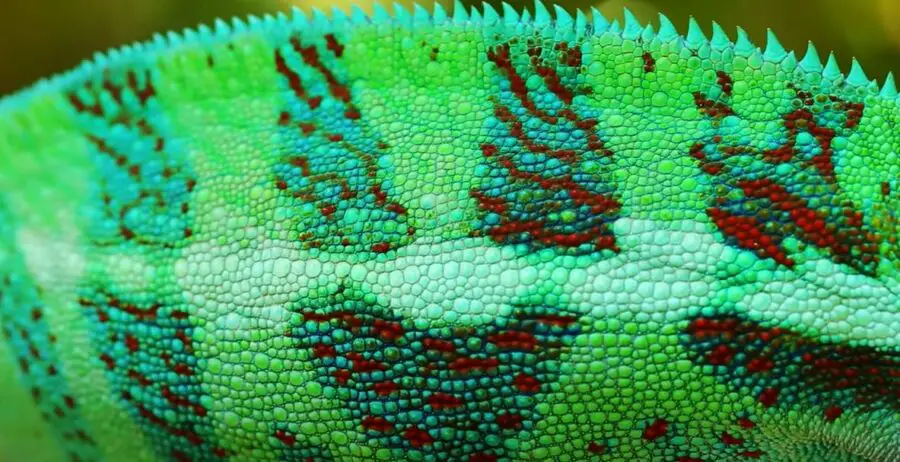Look closely and marvel at the intricate patterns on the body of your chameleon. Do chameleons have scales or is it something else you are noticing?
The answer is actually slightly more complicated. By reading this article, you will get a better idea at how chameleons change color.
Scales on reptiles are functional and serve many reasons that I will explain to you right now.
Do Chameleons Have Scales?
The layers of cells on a chameleon include scales. The pigments are made of criss-crossing patterns that operate like mirrors as they soak up and reflect the light around them from various surfaces.
This is how the scales end up mimicking the colors around them and camouflage responses to mirrored scales make chameleons ultra unique.
Scales on a chameleons are homogeneous when the shapes are the same as the ones around them or heterogenous as well with varying sizes.

Why Do Chameleons Have Scales?
Scales look so cool and in my opinion, the chameleon takes the cake from all reptile scales. They act as a defense mechanism or armor from quick bites that come from predators or insects trying to bite them when they are trying to protect themselves from these reptiles.
If a chameleon did not have scales, the injuries they can suffer without them could come from their own prey, nearby predators and the terrain which involves branches that are sharp and prickly.
Scales can produce patterns that resemble poisonous animals in the wild. Generally speaking, many bright colored snakes or even frogs in the amphibian world are known to be poisonous.
Chameleons can mimic such colors which warn possible predators of the added risk when they consider the gamble of attacking or consuming them as a possible meal.
How Can Scales Help Chameleons?
Not only do scales act as a sort of armor of added protection, they can help with water retention as well. In hot, arid and dry lands, reptiles like chameleons need to preserve their internal water and moisture.
The sun wishes to evaporate it through their pores, but the addition of scales prevents dehydration and adds another method of survival through such unforgiving terrains and landscapes.
Chameleons and many other reptiles can thank their scales for the added safety, security and water retention they provide.

Do Veiled Chameleons Have Scales?
Yes. The veiled chameleon is one of the most popular species that are available for reptile caregivers to bring home. You must care for veiled chameleons with extra sensitivity because they are known to be standoffish and unfriendly until they settle into their habitats.
They are not fans of intruders or guests and sudden movements. The predominant color on a veiled chameleon is green.
They have patterns of scales that mix blues and yellow together. The tightly packed scales on skin produce a blue color while the light absorbed around them mirrors a yellow color.
This is how the dominant green color is noticed when blues and yellow mix together seamlessly on their scales.
How Do Scales Camouflage a Chameleon?
The elaborate colors on a chameleon are possible by varied shapes, sizes and colors of scales on their outer body. This can help them mirror surfaces and blend in with their surroundings like no other type of animal can.
Chameleons absorb light through the sun or in their enclosure from lamps to create lighter or darker hues on their body which usually matches the colors around them if they wish to camouflage themselves.
Sometimes a chameleon uses scales and color changes to stand out during mating season or to ward off threats when they are discovered.
Bright colors resemble poisonous reptiles and amphibians and messing with a chameleon that is striking in color could be risky for a predator who is trying to avoid being poisoned. Since chameleons don’t carry venom, their scales are mimicking poisonous animals which gives them an added advantage.

Do Chameleons Have Scales, Skin, or Scaly Skin ?
Scales on chameleons overlap. There is still skin between the scales, but when they move, the overlapping scales cover the skin.
You can say that chameleons have skin with scales. Scaly skin is another way you can describe it as well.
There are layers to this skin with pigments produced by underlying cells. The body is full of bumps or also known as tubercules.
How Do Chameleon Scales Reflect Light?
The scales on chameleons resemble crystals patterns that look like latticed criss-crossing throughout their bodies. As they move, they absorb different light that they can process with various colors.
How Do Chameleons Change Color?
When the crystals are packed lighter in the lattice formation, it would be easier for us to see a blue reflection. When you look closely at these scales, some scientists might say that you are actually looking at skin that resembles mirror-like qualities.
When light travels across the scales of a chameleon, the tiny mirrors or crystals bounce the light and you will see more yellow pigments or brighter colors. The most predominant color we see is green when the blue and yellows are mixed together.
Loose skin means that the cells on their skin separate or are further apart. Thai is when we see more red colors. Red on top of yellow stretches out layers to create orange.
The nerves of a chameleon have some control over these color changes as well, but scientists are still trying to hypothesize various factors without conclusive details to exactly how these color changes are achieved.
Thank you for visiting PocketPetCentral.com for the best information to help you enjoy the life of your pocket pet companion in a fun, safe & healthy way. Enjoy your chameleons and the beauty of their scales to reflect light while creating magnificent colors.

